As we conclude this exclusive MPN series, we compare Operation Pacific Eagle to the notorious counterinsurgency initiative “Plan Colombia” and look at how the new Pentagon mission enables the U.S. to continue encircling China with its military bases. We speak to exiled Filipino revolutionary Jose Maria Sison and Professors William I. Robinson and Roland Simbulan.
In Part One, we discussed the armed struggle on the southern island of Mindanao and its nearly trillion dollars in mineral deposits — a crucial motive for Washington to prioritize the Philippines as a major military theater on the same scale as Syria and Iraq.
In Part Two, we explored the history of U.S. colonialism and imperialist domination of the Philippines — and President Rodrigo Duterte’s inability to forge an independent foreign policy free of Washington’s dictates.
MANILA, PHILIPPINES — While the Pentagon’s latest major mission, Operation Pacific Eagle, does represent a major boost to the U.S. military presence in the Philippines, in many ways it’s old wine in a new bottle.
The overseas contingency operation is a spinoff of Operation Enduring Freedom – Philippines — an intervention that began shortly after the World Trade Center attacks of September 11, 2001, and was used to justify U.S. participation in counter-insurgency operations primarily targeting the Moro Islamic Liberation Front and the Maoist fighters of the New People’s Army (NPA), the latter of whom formed in 1968 and have been fighting ceaselessly ever since.
On the pretext of President George W. Bush’s “Global War on Terror,” Washington used the manufactured “terrorism” bogeyman to reestablish its military bases in strategic locales across the world in preparation for future wars — with China slotted into the role of the U.S.’s long-term strategic rival.
With the United States’ decline from regional hegemony palpable and the Philippines experiencing continued social unrest, Operation Pacific Eagle’s stated goal of combating “radicalization and violent extremism” in the Southeast Asian archipelago offers Washington and Manila a way to kill two birds with one stone. And of course, it uses the time-tested methods honed in other regions of strategic importance to the maintenance of Washington’s overseas empire and the stability of U.S.-loyal local elites.
Read more by Elliott Gabriel
- Operation Pacific Eagle in the Philippines: Washington’s New Colonial War
- Operation Pacific Eagle: Duterte Falls in Line with US Plans for the Philippines
- Inter-Korea Talks Score Gold at Olympics as US ‘Autopilot’ Diplomacy Wipes Out
- Will Petrodollar Give Way to Petroyuan? China Makes First Move this March
The casus belli for Operation Pacific Eagle — a spinoff of Operation Enduring Freedom themed on President Donald Trump’s war against so-called “Radical Islamic Terrorism” — closely resembles the past use of the “War on Drugs” as a pretext for the counter-insurgency program Plan Colombia.
That notorious program provided a major surge of U.S. aid to Colombian security forces, resulting in widespread bloodshed and rights abuses across the region. William I. Robinson — author and professor at the University of California, Santa Barbara — told MintPress News:
As with Plan Colombia, Operation Enduring Freedom provided a smokescreen behind which the U.S. reestablished the Philippines as a rearguard for renewed power project in Asia-Pacific precisely at a time when China was emerging as an economic powerhouse and the major regional power.”
Plan Colombia and the “Israel of Latin America”

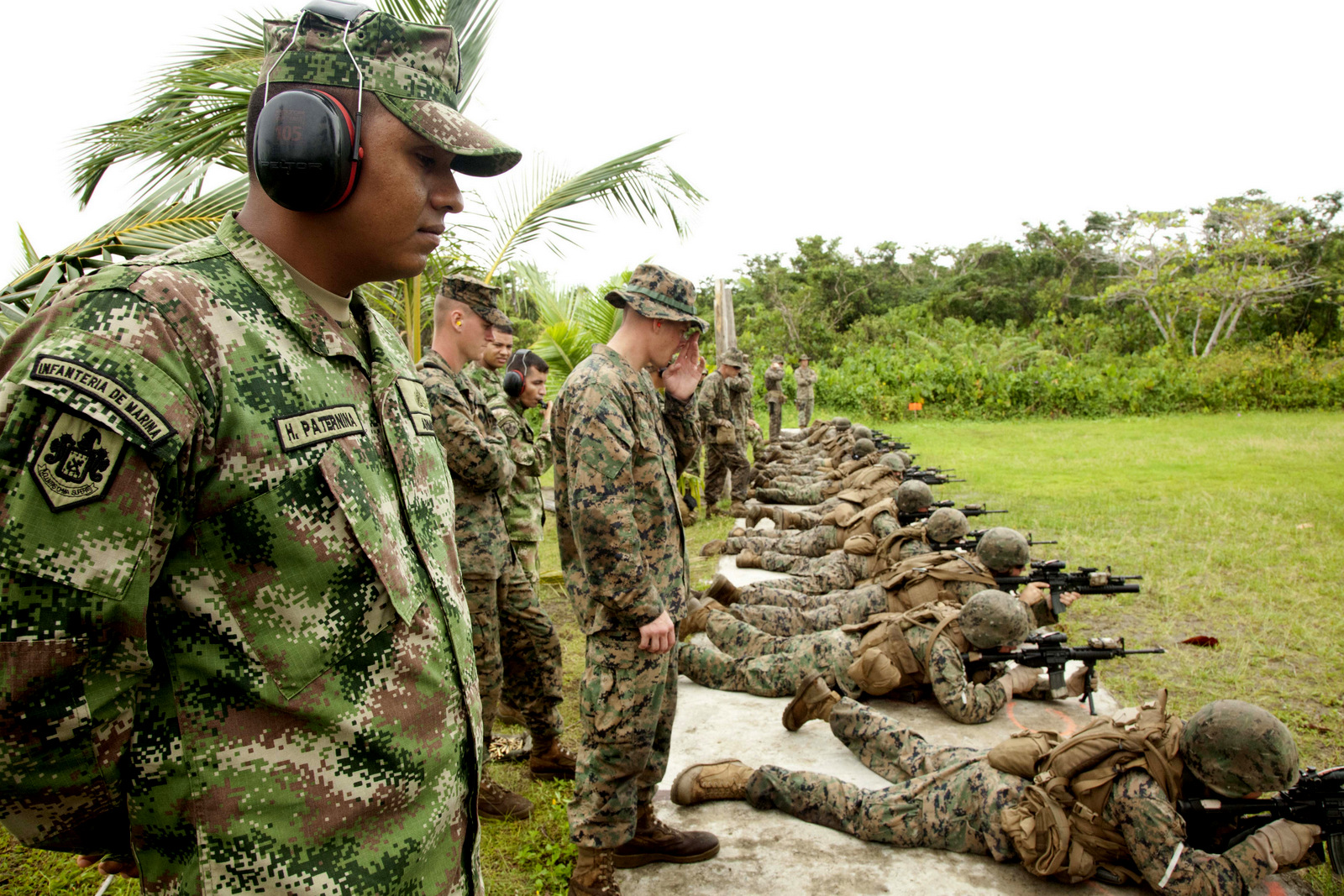
U.S. Marines with the Special Purpose Marine Air Ground Task Force (SPMAGTF) conduct advanced marksmanship training with Colombian marines in Matuntugo, Colombia, Nov. 7, 2011. (U.S. Army Photo)
With its lush, tropical land populated by diverse indigenous peoples, and its expansive cordillera mountain ranges rich in natural resources coveted by “growth”-obsessed bankers and profit-hungry multinationals, the Philippines enjoys multiple parallels with the South American nation of Colombia.
“The parallels between Colombia and the Philippines are significant,” Robinson said. “If Colombia is anything to go by, the social movements are the target of resurgent counterinsurgency in the Philippines.”
Since his work as a journalist in Nicaragua during the U.S.-backed counterinsurgency campaign of the 1980s, Robinson has written extensively about Washington’s bloody work of securing its interests in Latin America through pliant regimes willing to liquidate those who struggle, whether violently or peacefully, for social rights seen by the U.S. as cutting into the profits of its multinational corporations.
“Just as in Colombia, the Philippines is facing escalating political tensions and a surge of social conflicts and resistance movements, as the country moves towards a deeper crisis,” Robinson noted.
Watch | Plan Colombia: 15 years of tragedy
Until last June, Colombia was embroiled in a fierce 52-year insurgency spearheaded by the Revolutionary Armed Forces of Colombia – People’s Army, a Marxist-Leninist guerrilla force based in the countryside and known by its Spanish acronym, FARC-EP. Hundreds of thousands were killed and nearly six million people were displaced as Colombia’s state and non-state forces waged war on the leftist fighters of FARC-EP, the Army of National Liberation (ELN), and other groups such as the 19th of April Movement (M-19).
Security forces and right-wing paramilitaries resorted to tactics of blatant state terror, dubbed “political genocide” by Colombians. Between 1986 and 2013 according to the Pulitzer Center, over 2,800 union activists were butchered in the country – the highest rate of violence against labor movements in recorded history.
Despite the relentless counterinsurgency campaigns waged by successive right-wing governments, FARC-EP managed to stand firm. The tide began to turn in 2001 when the administration of U.S. President George W. Bush dramatically expanded the bilateral counterinsurgency initiative, Plan Colombia. Originally touted in 1999 as a regional variation of the “Marshall Plan” aimed at stemming the drug trade, the expanded plan saw billions of dollars in weaponry poured into the country’s security forces and paramilitaries by the U.S. government, while rural coca crops (and surrounding villages) were bombarded with the Monsanto herbicide glyphosate.

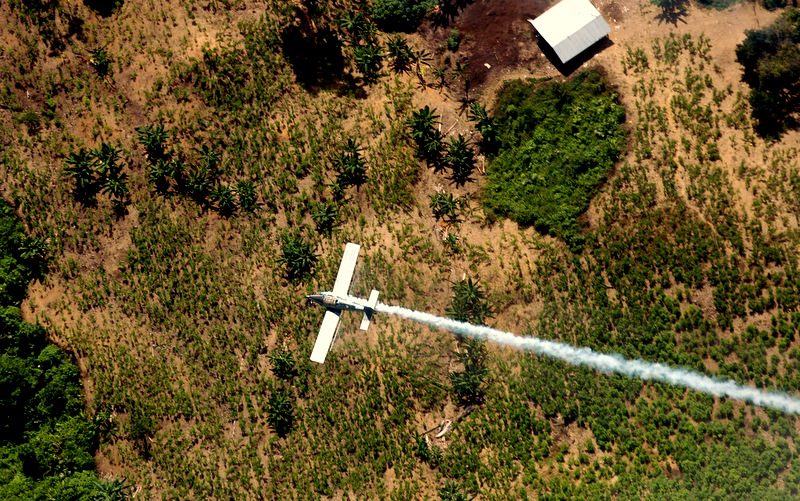
A plane sprays herbicides over coca fields in El Tarra, in the Catatumbo river area, near Colombia’s northeastern border with Venezuela (AP/Luis Robayo)
“Let us recall that Plan Colombia had two key objectives,” Robinson explained:
One was military: Plan Colombia provided a smokescreen for repression against social movements (that were often independent of the guerrillas) and counterinsurgency operations against the guerrillas in Colombia and also for intervention in the Andean region.”
After the Colombian military staged a cross-border attack into Ecuador on March 1, 2008 — killing multiple FARC-EP including top commander Raul Reyes with U.S.-provided precision weaponry, setting off a major regional crisis — Venezuelan President Hugo Chavez excoriated Colombia as a “terrorist state” serving the government of the U.S.:
The Colombian government has turned into the Israel of Latin America.”
A year later, Ecuador’s left-wing President Rafael Correa successfully ended the U.S. Air Force’s usage of the country’s Eloy Alfaro Military Base in the coastal city of Manta. The base was a major node of U.S. military and CIA operations in the region, as well as a crucial logistical and communications hub for Plan Colombia.
By October, 2009, Colombia and the United States had already fast-tracked an agreement allowing the U.S. military to use two naval bases, three air force bases, and two army bases in the Andean nation.
“Colombia became decisive for regional counterrevolution after South America’s turn to the left in the early 21st century,” Robinson noted:
But the other key objective of Plan Colombia – really the more important one — was what radical political economists refer to as ‘primitive accumulation.’”
Coined by 19th-century political economist Karl Marx and made famous in his landmark work Capital, the term “primitive accumulation” refers primarily to the dispossession of huge communities and population groups – artisans, subsistence farmers, rural campesinos, indigenous peoples – and the transfer of their land, wealth and bodies into the control of the capitalist class.

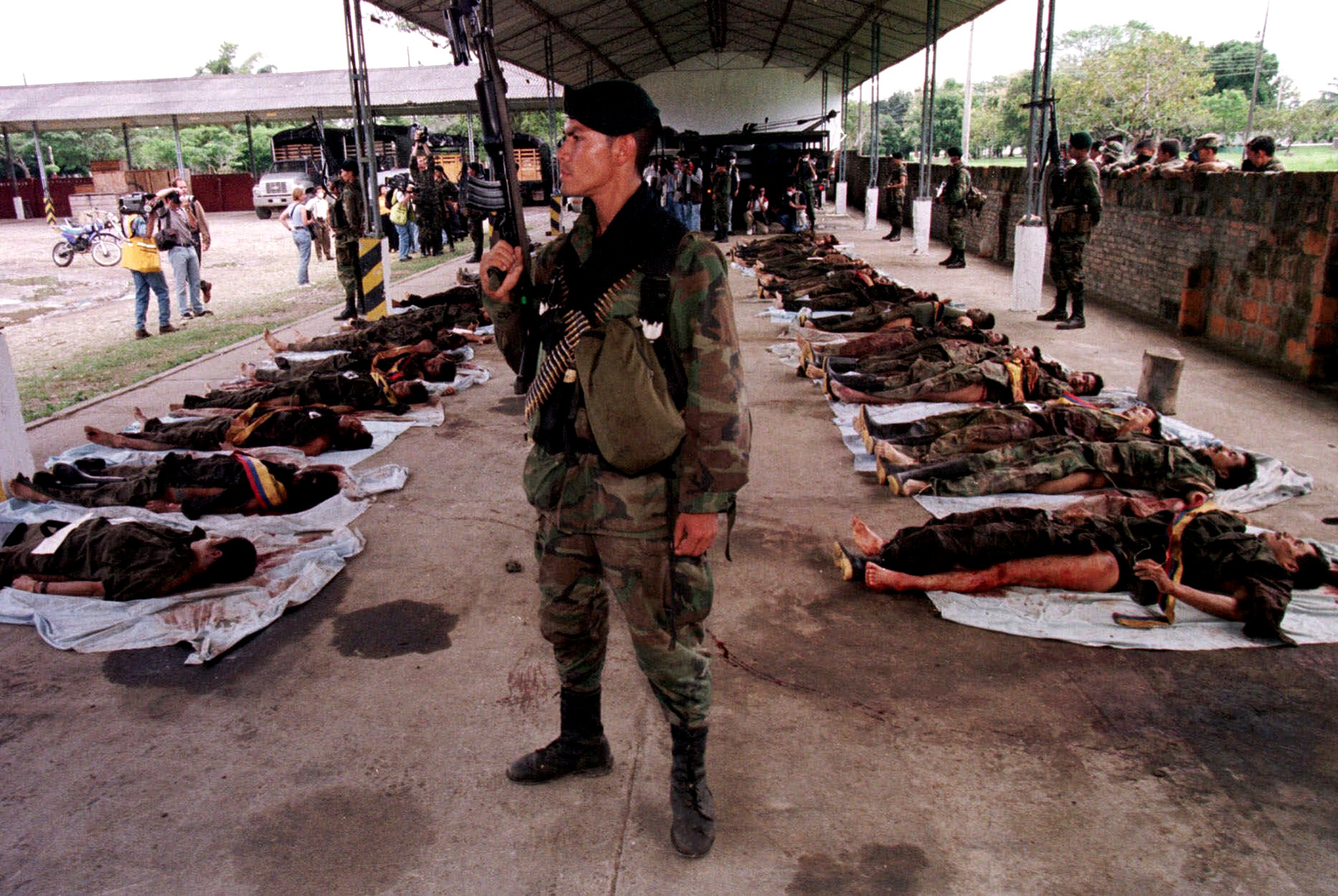
Colombian soldiers display the bodies of 30 Revolutionary Armed Forces of Colombia, or FARC, rebels to the prress in Granada, about 180 kilometers (112 miles) outside of Bogota, Colombia, Monday, July 12, 1999. (AP/Scott Dalton)
For Robinson and other analysts, Plan Colombia – on the pretext of the anti-FARC counterinsurgency and the farcical “War on Drugs” – was the vehicle through which the Colombian military and paramilitaries acting as agents of the U.S.-aligned oligarchy could unleash continued terror against the rural peoples including workers, trade unionists, students, and indigenous and Afro-Colombian communities. Robinson recounted:
Several million campesinos were displaced from the countryside and their lands taken over by transnational mining, agro-industrial, and energy interests. In this way, Plan Colombia was an instrument for capitalist globalization in that country and beyond, for opening up Colombian land and natural resources to transnational corporate plunder.
Transnationally-oriented factions among the Colombian capitalist class and elite came to the fore over the past couple decades precisely through militarization, repression, and primitive accumulation, in which Plan Colombia played a pivotal role.”
Facing a string of defeats, FARC-EP eventually negotiated a peace deal with Bogota that ended the conflict and transformed the group into a civilian political party, renamed the People’s Alternative Revolutionary Force (whose Spanish acronym remains FARC). Leaders of the group have angrily denounced Bogota for betraying the agreement, however, as ex-FARC combatants and social movement organizers continue to face murders at the hands of right-wing paramilitaries.
Robinson concluded:
The palm oil and sugar cane biofuel plantations, the gold, emerald and other mines, the agro-industrial flower complex, the oil and natural gas operations, new export-oriented industry, and so on, have all emerged as part and parcel of counterinsurgency, the war on rural communities, and the bogus ‘war on drugs.
Ever since the U.S. colonized the Philippines in 1898, that country had been a key surrogate for the projection of U.S. military power and economic and political influence in the Asia-Pacific region … [Similarly], Colombia has historically been a key U.S. ally – or surrogate — in Latin America and a rearguard for the U.S. military presence in South America.”
For Jose Maria Sison, the exiled 79-year-old revolutionary veteran and founding chairman of the Communist Party of the Philippines (CPP), the comparison is apt:
Operation Pacific Eagle is definitely an interventionist scheme of the U.S. to crush the Philippine revolution through a much closer coordination between the U.S. Armed Forces and Armed Forces of the Philippines, similar to the U.S. State Department’s Plan Colombia.”
Pacific Eagle and the Philippine “aircraft carrier”
Just as Plan Colombia was officially launched shortly after the election of Hugo Chavez and accelerated just as the so-called “pink tide” began ushering in a period of progressive anti-imperialist governance across Latin America, Operation Pacific Eagle appears aimed at consolidating Washington’s Asian presence in the face of various threats to its regional hegemony. Robinson stated:

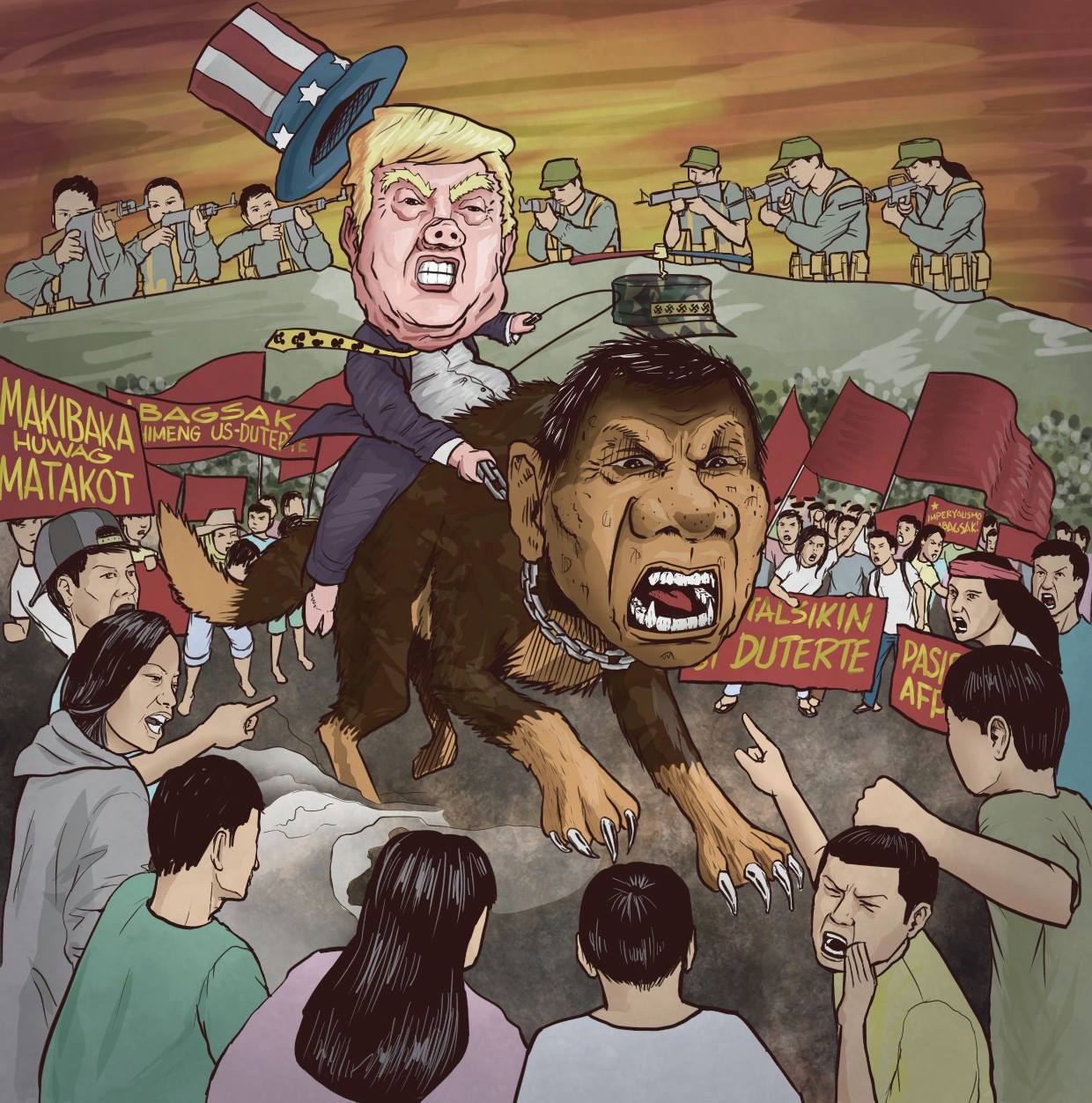
Image: Communist Party of the Philippines Information Bureau
[It] appears to be a major escalation of U.S. intervention in the Philippines at a time when tensions in the Korean Peninsula are becoming explosive and when China is transitioning from a regional to a global power. And just as in Plan Colombia, there is both the regional and the internal dimension.”
Sison affirmed that the Philippine leftists fully recognize the perils they could face under the Pentagon operation:
The CPP, NPA and [National Democratic Front of the Philippines] are well aware of how the U.S. used Plan Colombia to organize paramilitary forces under the pretext of combating the coca plantations and drug trade only to turn these forces against the revolutionary forces and the people.
The CPP, NPA and NDFP have learned a lot of negative lessons from the peace agreement of FARC-EP with the Colombian government in the 1980s and currently.
Duterte was a ready tool for appearing as a strong man against the drug problem and for popularizing mass murder as a method in the war on drugs and subsequently in the war against the revolutionary movement. Early on, however, the CPP and NPA noticed that suspected revolutionaries were being murdered as ‘drug suspects’ and became alerted to the danger that the war on drugs would be combined with the counterrevolutionary war.
This Operation [also] categorically puts the U.S. in a superior position relative to other foreign powers like China and Russia.”
The China question

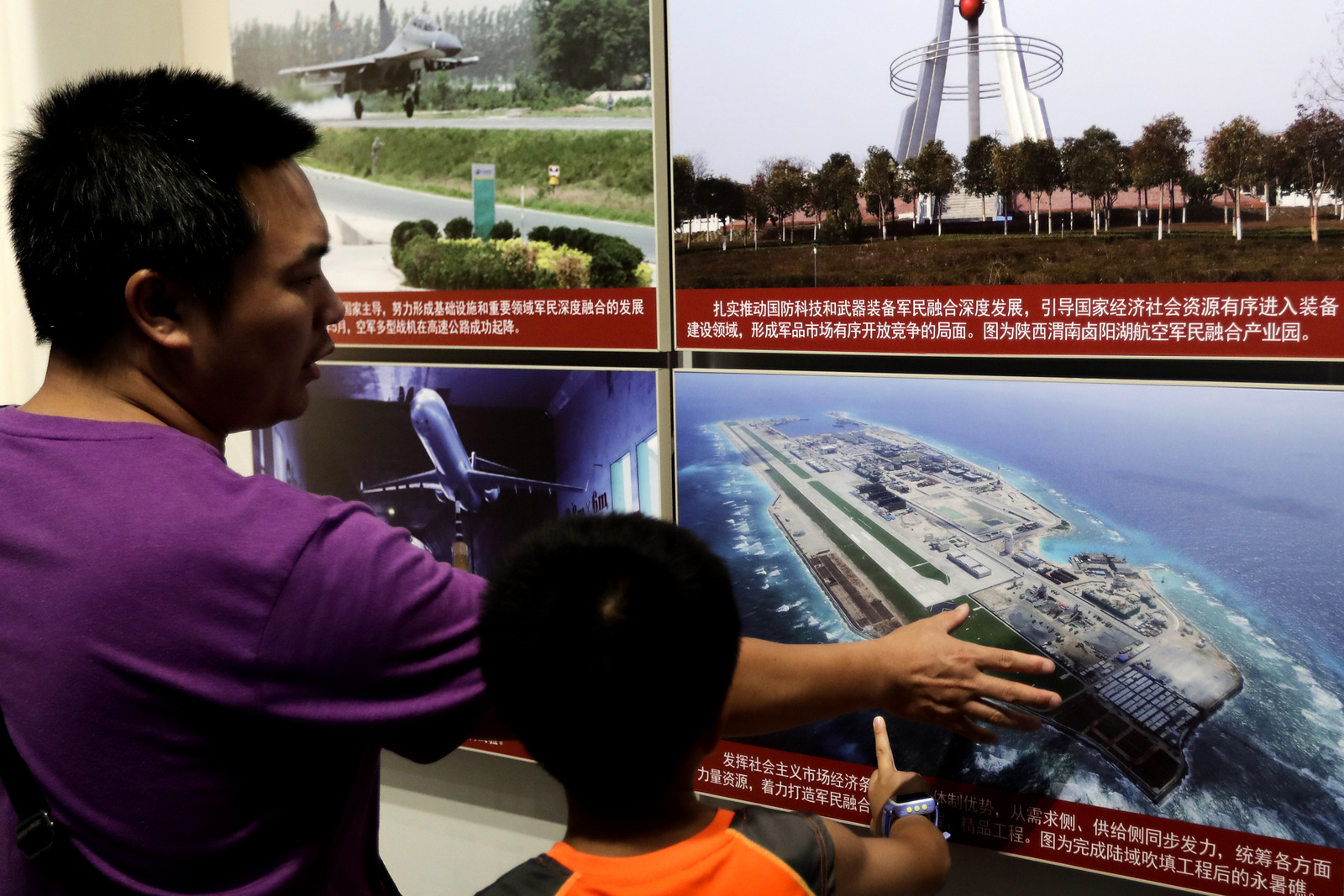
A man and a child look at a picture showing the Fiery Cross Reef in the Spratly islands, in the disputed South China Sea, on display at the military museum in Beijing, July 27, 2017. (AP/Andy Wong)
Operation Pacific Eagle places President Rodrigo Duterte in an ever-increasingly complicated foreign policy bind. Rather than forging an independent path, the outspoken president is finding himself constricted by an accumulating number of obligations to China and the U.S. In Sison’s words:
The Duterte regime seems to be trying to make the Philippines a condominium of foreign powers or subdivide it into several spheres of influence for the U.S., Japan, China and Australia. To some extent, he has some autonomy. But this is not enough to overturn U.S. dominance over the Philippines.”
While Duterte pledged during his election campaign to defend the Philippines’ territorial claims in the South China (or West Philippine) Sea by riding a jet ski to the contested Spratly Islands himself, if necessary, recent revelations cast doubt on his ability to defend the Philippines’ 200-mile exclusive economic zone through such daredevil tactics.
Last week, Philippine news agency The Daily Inquirer posted a set of aerial photos captured by AFP intelligence that show the stunning extent to which China has transformed the archipelago into a chain of ultra-modern, highly-equipped military fortresses – complete with runways, lighthouses, missile launch facilities, naval docks, armored hangars, radar and surveillance systems.
When presidential spokesman Harry Roque asserted that “those artificial islands will be ours if we can ask China to leave the islands,” the president’s detractors accused Malacañang of selling the country out to China for a handful of loans.
Wach | Pictures show China militarisation of Spratly islands
“Treasonously, the Duterte regime has violated the sovereign rights of the Filipino people,” Sison said, continuing:
It has given big concessions to China: 100 percent of the Philippines´ extended continental shelf and 80 percent of its exclusive economic zone in the West Philippine Sea. The regime has given to China the way to the exploitation of the mineral and marine resources of the West Philippine Sea. It has surrendered to China the sovereign rights of the Philippines defined in the U.N. Convention on the Law of the Sea and decided by the permanent court of arbitration in The Hague.”
Posing as an iron-fisted authoritarian at home and a fierce nationalist on the international stage, Duterte’s feckless and ill-considered policies have underscored the all-around dependent nature of the Government of the Republic of the Philippines.
“But just the same, we cannot fight America, just like China. I’ll just keep quiet,” Duterte told journalists last Friday. “But if you get something there from the economic zone, I will order the navy to fire,” he added with characteristic muddled bravado.
With People’s Liberation Army of China troops and U.S. Armed Forces personnel now stationed within the internationally-recognized borders of the Philippines, the country itself is now contested grounds in the broader struggle between a declining U.S. and a rising China.
“The U.S. and China are now in a Thucydides Trap, with each side driven to react strongly to what it considers as detrimental coming from the other side,” Sison said, concluding:
The inter-imperialist contradictions are now intensifying mainly because of the growing rivalry between the U.S. and China. The U.S. appears to be the more desperate economically and more aggressive militarily, while China tries to strengthen itself by creeping on weaker countries and avoiding sharp contradictions with the U.S.”
Lessons for Filipinos

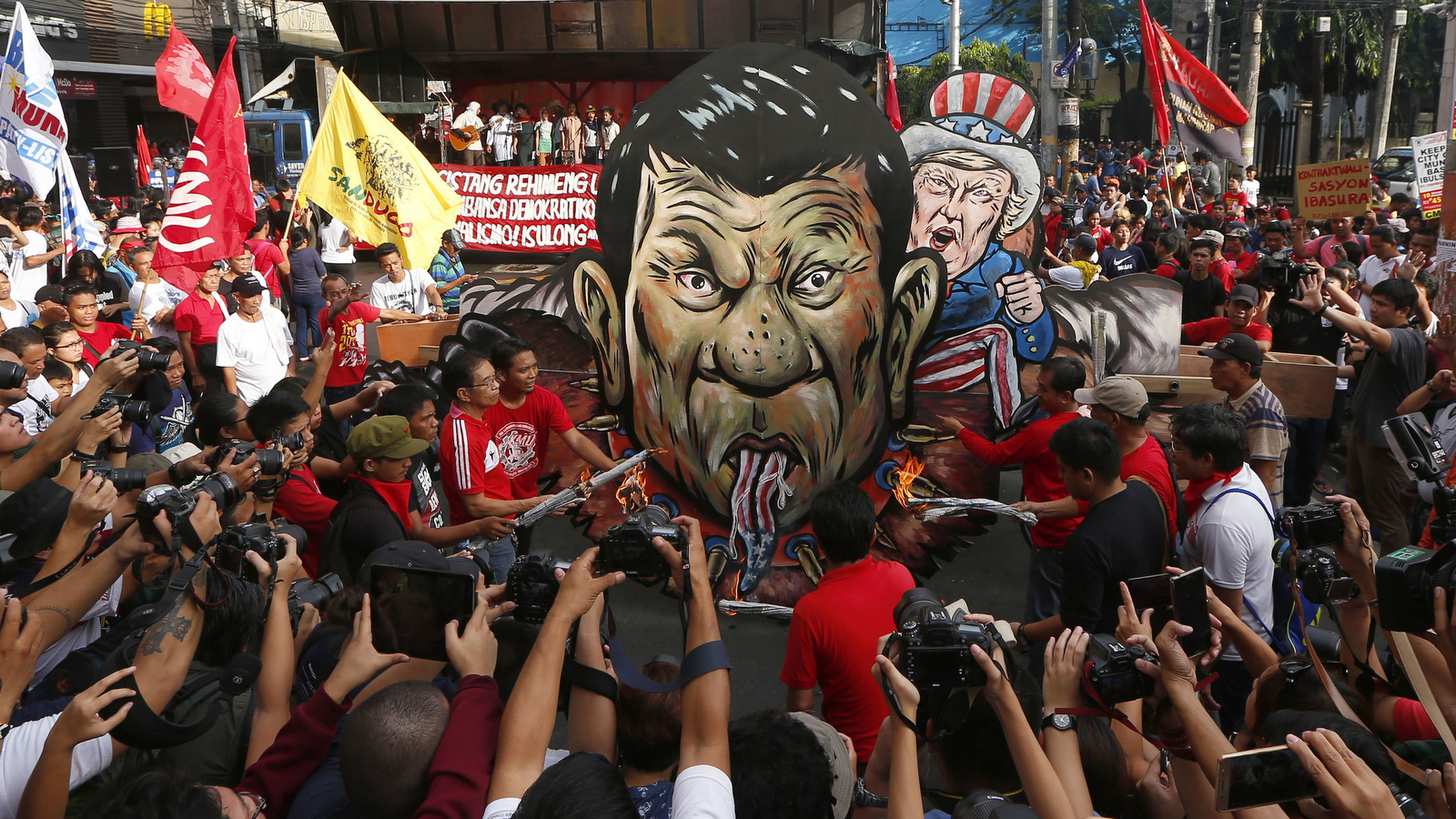
Protesters burn the effigies of President Rodrigo Duterte, left, and U.S. President Donald Trump during a rally near the Presidential Palace to mark the 154th birth anniversary of the country’s revolutionary hero Andres Bonifacio, Nov. 30, 2017, in Manila, Philippines. (AP/Bullit Marquez)
While Duterte’s foreign policy strategy has been consistently incoherent, his message for the country’s progressive movements and communists over the past several months has been consistently menacing.
The president is currently facing a storm of outrage in response to his threats directed toward women combatants of the NPA, notably that the AFP should shoot them in their genitalia:
Tell the soldiers. There’s a new order coming from the mayor … We won’t kill you. We will just shoot your vagina so that … if there is no vagina, it would be useless.”
Mainstream media outlets, feminist organizations, and social movements have greeted the comments as a grim sign of things to come. Cristina Palabay, the secretary general of leftist human-rights group Karapatan, said that the comments show how:
President Duterte has distinguished himself as a frothing-in-the-mouth fascist, who incites the worst violations of international humanitarian law, aside from his exhortations to his State forces to disregard basic human and people’s rights.”
WAR in itself is an eco-system of violence. The singling out of women as specific targets of violence and subjects of particular punishment is NOT a joke. #WarCrime pic.twitter.com/MDiJOWIz7u
— inday espina varona (@indayevarona) February 12, 2018
There’s a growing sense that Operation Pacific Eagle sets the stage for Duterte to enjoy nearly unlimited backing from his U.S. counterpart, Donald Trump, whose piggish “grab them by the pussy” remark seems almost mild in comparison.
Professor Roland Simbulan of the University of the Philippines said:
Expect more joint military exercises between U.S. intervention forces with Philippine and ASEAN counterparts, closer collaboration with local security forces under the guise of anti-drug operations and humanitarian/disaster assistance.
This is also to disguise its support for the internal suppressions of the Philippine Left, both armed and unarmed, so that the pro-U.S. Philippine elite can continue in power without being challenged by so-called ‘threat groups’ from the increasingly politicized masses and non-elite allies. Since the liberal democratic regimes after the Marcos dictatorship could not defeat the Philippine Left, the U.S. under Trump will now once again try to use blatantly fascistic methods to deal with progressive forces.”
Watch | Why is there an armed revolution in the Philippines?
Confident that Duterte — like his predecessor, dictator Ferdinand Marcos — will unwittingly be the “best recruiter for the New People’s Army,” the CPP remains undaunted by the repression it’s facing or the joint U.S.-Duterte offensive that looms. In a statement earlier this month, the CPP said:
Let the call to overthrow Duterte echo in schools, factories, markets, communities, barrios and other population centers … Most importantly, the New People’s Army must carry out significant tactical offensives to rock Duterte’s fascist reign. His fascist troops must not be allowed to lord over the countryside.”
New People’s Army National Operations Command spokesman Jorge “Ka Oris” Madlos affirmed to MintPress News the NPA’s will to continue its fight for national self-determination as well as political and social rights for the poor:
If the Duterte regime reopens peace talks, the revolutionary movement will negotiate with him as it did with previous U.S. stooges. In principle, the movement is always open to peace negotiations. Procedures and previous agreements are in place to safeguard the interests of the people and avoid the trap of ‘unjust’ peace deals similar to Colombia.
But the NPA will not surrender to a U.S. puppet state, nor will it consider laying down its arms without substantial social and economic changes.”
As the Pentagon digs its heels in and prepares to hurl money into the furnace of Operation Pacific Eagle-Philippines in hopes to end a half-century-long communist rebellion and clear the obstacles to U.S. control, the fact remains: for hundreds of years the blood shed in the country has only served to feed the roots of resistance.
Without a doubt, the people of the Philippines will continue to fight as long as they’re deprived of justice, dignity, and the pride of determining their own future on the earth beneath their feet.
Top Photo | Protesters march towards the Presidential Palace with the effigies of President Rodrigo Duterte and U.S. President Donald Trump to mark the 154th birth anniversary of the country’s revolutionary hero Andres Bonifacio, Nov. 30, 2017 in Manila, Philippines. (AP/Bullit Marquez)
Elliott Gabriel is a former staff writer for teleSUR English and a MintPress News contributor based in Quito, Ecuador. He has taken extensive part in advocacy and organizing in the pro-labor, migrant justice and police accountability movements of Southern California and the state’s Central Coast
<!–
–>
Source Article from https://www.mintpressnews.com/operation-pacific-eagle-the-us-and-duterte-take-aim-at-china-and-the-armed-poor/237942/
 RSS Feed
RSS Feed















 February 22nd, 2018
February 22nd, 2018  Awake Goy
Awake Goy  Posted in
Posted in  Tags:
Tags: 













